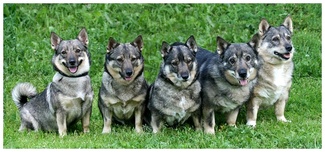Swedish Vallhund retinopathy
 Photo Inga Kahlman |
Retinopathy is a hereditary eye disease where the rod and/or cone cells of the retina (photoreceptors) are damaged. The damage of these retinal cells causes changes in the dog's vision and may lead to complete loss of vision. Retinopathy has been diagnosed in several dog breeds and in several of these the gene causing the condition has been identified. Many of the identified genes are the same as the genes causing the disease in humans. However, there are breeds where the genetic background of retinopathy is still unknown.
We study hereditary retinopathy in the Swedish Vallhund. The retinopathy diagnosed in the breed is specific only to this breed. The same clinical symptoms are not known to occur in other breeds. Our research group is collecting samples of both dogs diagnosed with retinopathy and dogs declared healthy in an eye examination. The aim of our research is to identify the gene causing retinopathy and to develop a gene test. A gene test would make it possible to find out whether a dog is in risk of getting the disease. Genetic testing would also help breeders to eliminate the disease from the breed, while preserving the genetic diversity in the breed.
Clinical research of retinopathy in the Swedish Vallhund has been conducted in both Finland and the United Stated (Michigan State University) with DAVCO and DEVCO diplomate Dr. András Komaromy, in the leading role. In Finland, the veteriny ophthalmologist Päivi Vanhapelto has also participated in the study. During the clinical study the changes in the retinas of affected dogs have been monitored for several years. Based on the findings, the disease can be divided into three stages.
Stage 1 is characterized by multifocal brown or gray discolorations of the tapetal fundus without any signs of vision deficit. In Stage 2, the retina is starting to thin. These degenerative areas expand and eventually merge in Stage 3. Stage 1 is typically seen at 2 - 3 years of age, and the changes progress slowly. Stage 3 is typically seen after 9 years of age. However, both the age of onset and the rate of progression vary considerably. Night vision deficits are first observed in Stage 2, and day vision becomes affected as the disease progresses. The recorded retinal function shows a dramatic loss of rod photoreceptor-mediated responses.
Our research group has analysed known canine retinopathy genes in the Swedish Vallhunds and excluded them as causative. Further studies have revealed a region in one of the dog's chromosomes where the disease causing gene is located. The region is large and we are currently studying the entire region, the genes in that region, and the areas between the genes.